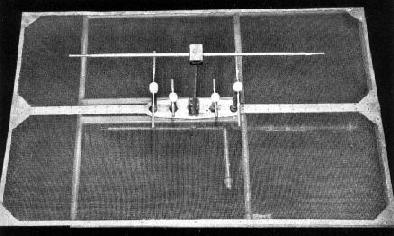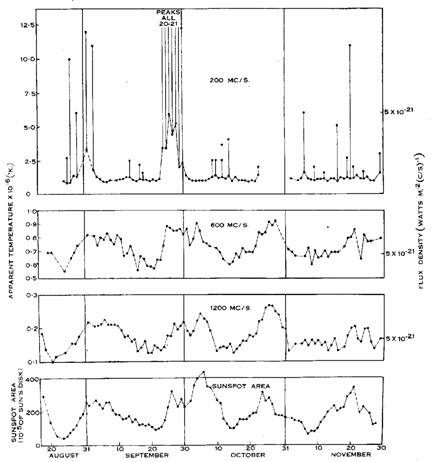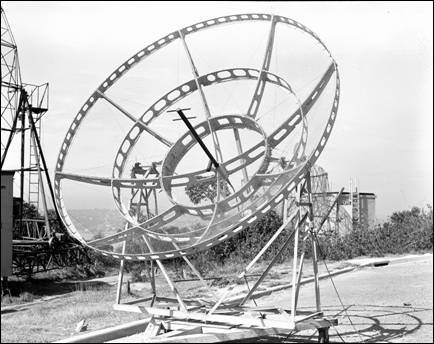Radio astronomy at the short-lived Georges Heights field-station
Introduction
One of the features of Australian radio astronomy during the late 1940s, was the existence of a number of field stations maintained by the CSIRO's Division of Radiophysics (henceforth RP) at former WWII radar stations (Sullivan, 1988). The best-known of these was located at Dover Heights, but it is not widely known that RP also maintained a field station at Georges Heights in 1947 - 1948, and that this was involved in pioneering solar radio astronomy.
Solar monitoring at Georges Heights
The Georges Heights radar-station occupied an attractive strategic position on Middle Head, overlooking the entrance to Sydney Harbour and during the war was home to a number of different radar antennas. One of these was an experimental unit featuring a 4.3 × 4.8-m section of a parabola with a cumbersome alt-azimuth mounting (Figure 1), and the only way it could be used for radio astronomy was to place the antenna ahead of the Sun, let the Sun drift through the beam, hand-crank the antenna ahead of the Sun again, and repeat the process throughout the day. This procedure produced a distinctive "picket fence" chart record. At this time, Payne-Scott and her collaborators were monitoring solar activity from Dover Heights, using 60, 100 and 200-MHz Yagis, and the Georges Heights antenna allowed the frequency-coverage to be extended to 1200 MHz.

Figure 1: Joe Pawsey (left) and Don Yabsley (right) with the 4.3 × 4.8-m ex-radar antenna on 1 May 1947 (ATNF Historic Photographic Archive: B1031-9). The insert shows the 200, 600 and 1200-MHz dipoles (after Lehany and Yabsley 1949: Plate 2).
Assigned to this antenna were two young RP radio engineers, Fred Lehany and Don Yabsley. New Zealand-born Lehany had a M.Sc. from the University of Otago, and during WWII was employed by AWA. Between 1945 and 1948 he worked at RP as a Senior Research Officer, before transferring to the National Standards Lab - where he eventually assumed the post of Director. Thus, his involvement with radio astronomy was short-lived, and his Georges Heights project " came about in a typical `Pawseyian way', before I knew what was happening. there was an observing program and Yabsley and I were a suitable pair to share not only the week days but also the weekend duty " (Lehany, 1978).
His companion, Don Yabsley, joined RP as a Assistant Research Officer in 1944 after completing a B.Sc./B.Eng. at Sydney University, and worked on the LORAN project (Yabsley, 1978). Immediately after the War, he observed the Sun at Dover Heights with Ruby Payne-Scott, before transferring to Georges Heights in 1947. There he was responsible for designing and building the triple-feed system that allowed the ex-radar antenna to operate simultaneously at 200, 600 and 1200 MHz (see Figure 1 insert).
Meanwhile, Lehany's special contribution " was the provision of a cavity filter at the input of both the 600 MHz and 1200-MHz mixer receivers, thereby suppressing the unwanted image frequency and higher frequency bands using harmonics of the local oscillator for frequency conversion. Thus each of these receivers was essentially monochromatic and this feature facilitated the achievement of accurate calibration of flux densities. He was also responsible for providing the matched hot loads used to perform the calibration." (Yabsley 1986).
Assisting Lehany and Yabsley in June-August 1947, mainly during the development of the receivers and feed systems and operational testing of the antenna, was a young Technical Assistant named Bruce Slee. Later Slee would establish an international reputation through his work at Dover Heights, Fleurs, Parkes and Culgoora (see Orchiston, 2004). A frequent visitor to Georges Heights during the developmental phase was one of RP's receiver "gurus", Lindsay McCready, and Slee recalls that Ruby Payne-Scott and Joe Pawsey (head of the radio astronomy group within RP) were occasional visitors. Pawsey and Yabsley are shown in Figure 1.

Figure 2: The correlation between sunspot area and solar flux at 600 and 1200 MHz in 1947 (after Lehany and Yabsley 1949: 56)
By August 1947 the equipment was fully operational and in the first instance solar monitoring was carried out for about two hours daily, from 18 August until 30 November, resulting in the detection of many bursts at 200 MHz. In contrast, bursts were rare at 600 and 1200 MHz, where the general flux variations with time were correlated with sunspot area (see Figure 2). This distinctive pattern was discussed by Lehany and Yabsley in papers published in Nature and the Australian Journal of Scientific Research in 1948 and 1949 respectively, along with those rare outbursts that would now be classed as Type II events.

Figure 3: One of the simple 3-m diameter alt-azimuth-mounted "solar eclipse" antennas undergoing testing at Georges Heights in August 1948 (ATNF Historic Photographic Archive: B1511).
During mid-1948 the Georges Heights field-station was used as a test-base for two portable 3-m dishes, that were constructed in order to observe that year's 1 November partial solar-eclipse from Rockbank (Victoria) and Strahan (Tasmania). One of these antennas is shown in Figure 3. Ironically, this eclipse was the death-knell for Georges Heights as a radio-astronomy facility: a decision was made to transfer the ex-radar antenna to the Potts Hill field-station, where it would be used to monitor the eclipse.
Concluding remarks
For less than a year, Georges Heights played a significant role in the early development of solar radio astronomy in Australia. Research carried out there by Lehany and Yabsley aided our understanding of the association of 200-MHz bursts and solar flares, and of the correlation between sunspots and radio emission at 600 and 1200 MHz.
It is interesting to note that Georges Heights provided Lehany with his sole research foray into radio astronomy, a field in which he admitted to having little interest (Lehany, 1978), whereas it proved the perfect radio astronomy training ground for a youthful Don Yabsley. Although he spent 1951 - 1961 working in the air navigation group at RP, Yabsley returned to radio astronomy once the Parkes Radio Telescope was commissioned, and was involved in a number of collaborative research projects and in the up-grading of the dish. His unexpected death late in 2003 robbed Australian radio astronomy of one of its pioneers.
What of the Georges Heights site? Consolidation of research at the Dover Heights field-station, and development of a new multi-facetted research facility at Potts Hill, saw the ending of radio astronomy at Georges Heights towards the end of 1948 - but not before the ex-radar antenna was transferred to Potts Hill, where it was used over many years for solar and galactic research, including the first Australian H-line observations.
References
Lehany, F.J., 1978. Taped interview with Woody Sullivan. Transcript, Sullivan Collection, Seattle
Lehany, F.J., and Yabsley, D.E., 1948. Nature, 161, 645
Lehany, F.J., and Yabsley, D.E., 1949. Austr. J. Sci. Res. A, 2, 48
Orchiston, W., 2004. PASA, 21, 23
Sullivan, W.T., 1988. Early years of Australian radio astronomy. In Home, R. (ed.). Australian Science in the Making. Cambridge, Cambridge University Press, 308
Yabsley, D.E., 1978. Taped interview with Woody Sullivan. Transcript, Sullivan Collection, Seattle.
, 1986. Letter to Woody Sullivan dated October 10. Original in Sullivan Collection, Seattle
Wayne Orchiston
(Wayne.Orchiston@csiro.au)
